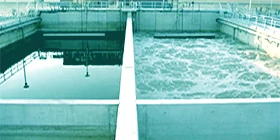
The Sequencing Batch Reactor (SBR) is a type of conventional activated sludge system for wastewater treatment. Oxygen is bubbled through the activated sludge and wastewater mixture to reduce the organic matter measured as biochemical oxygen demand (BOD) and chemical oxygen demand (COD). The treated wastewater may be suitable for discharge into surface water or possibly for use on land.
The process can be performed in batches, where the different conditions are all achieved in the same reactor but at different times The treatment consists of a cycle of five stages: fill, react, settle, draw, and idle. An aeration technology gives oxygen during the reaction. During this phase, microorganisms oxidize the organic waste in the same way as they do in activated sludge systems. Aeration is then turned off to enable the sediment to settle. The water and sludge are separated by decantation in the next phase, and the clear layer (supernatant) is ejected from the reaction chamber. Some sludge may also be purged, depending on the pace of sludge generation. After a period of inactivity, the tank is refilled with a fresh batch of effluent. Because continuous influent must be held throughout the operating period, at least two tanks are required for batch mode operation. Smaller systems may need one tank. In this situation, the influent must either be kept in a pond or continually released to the tank bottom to avoid disrupting the settling, draw, and idle phases. Because the capacity of each tank is dictated by the amount of wastewater generated during the treatment period in the other tank, SBRs are best suited to lower flows.
Mechanical equipment, such as pumps, aerators, and mixers, and the delivery of oxygen and return activated sludge requires routine maintenance and control. Controlling sludge concentrations and oxygen levels in aeration tanks is essential, and technical equipment (e.g., pH meter, temperature, oxygen content, and so on) must be appropriately maintained. The influent and effluent should be regularly monitored and managed to ensure that optimal living conditions for the needed microorganisms are maintained. That effluent quality is fulfilled (e.g., by a centralized computerized monitoring system).